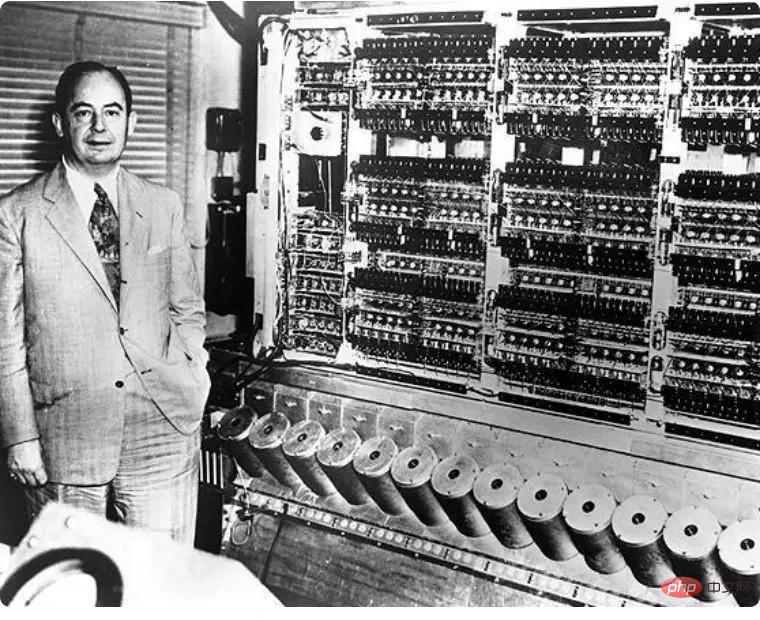What are the two major improvements of EDVAC?
EDVAC has two major improvements: one is the use of binary, and the other is the completion of the stored program, which can automatically advance from one program instruction to the next, and its operations can be automatically completed through instructions. "Instructions" include data and programs, which are input into the memory device of the machine in the form of codes, that is, the same memory device that stores data is used to store instructions for performing operations. This is the new concept of so-called stored programs.

The operating environment of this tutorial: Windows 7 system, Dell G3 computer.
The Discrete Variable Automatic Computer (English: Electronic Discrete Variable Automatic Computer, EDVAC) is an early American electronic computer. Unlike its predecessor ENIAC, EDVAC used binary and was a von Neumann architecture computer.
In 1946, when von Neumann was developing the EDVAC computer, he proposed two important improvements: first, the use of binary, and second, the completion of the stored program, which can automatically From one program instruction to the next, the work can be completed automatically through instructions. "Instructions" include data and programs, which are input into the memory device of the machine in the form of codes, that is, the same memory device that stores data is used to store instructions for performing operations. This is the new concept of so-called stored programs. This concept has been hailed as a milestone in the history of computing. Von Neumann, who contributed to this program, is known as the "Father of Computers."
 In 1945, von Neumann drafted a 101-page summary report titled "Draft Report on EDVAC". The report presented broadly and specifically new ideas in building electronic computers and programming. This report is an epoch-making document in the history of computer development. It announces to the world that the era of electronic computers has begun.
In 1945, von Neumann drafted a 101-page summary report titled "Draft Report on EDVAC". The report presented broadly and specifically new ideas in building electronic computers and programming. This report is an epoch-making document in the history of computer development. It announces to the world that the era of electronic computers has begun.
The EDVAC plan clearly laid out that the new machine is composed of five parts, including: arithmetic unit, logic control device, memory, input and output equipment, and described the functions and interrelationships of these five parts. In the report, Neumann further demonstrated the two major design ideas in EDVAC, setting a milestone for computer design.
One of the design ideas is binary. Based on the bistable working characteristics of electronic components, he suggested using binary in electronic computers. The report mentioned the advantages of binary and predicted that the adoption of binary will greatly simplify the logic circuit of the machine.
Expand knowledge:
It can be said that EDVAC is the first general-purpose computer in the modern sense. Unlike ENIAC, the world's first electronic computer, EDVAC used binary instead of decimal for the first time. The entire computer uses a total of about 6,000 electron tubes and about 12,000 diodes, has a power of 56KW, covers an area of 45.5 square meters, and weighs 7850KG. It requires thirty technicians to operate at the same time.
It consists of five basic parts: 1) operator CA (2) controller CC (3) memory M (4) input device I (5) output device O;
This This architecture has continued to this day. The basic working principles of computers used today are still stored programs and program control, so computers are now generally called von Neumann architecture computers. In view of the key role von Neumann played in the invention of electronic computers, he is hailed by Westerners as the "Father of Computers".
For more related knowledge, please visit the
FAQThe above is the detailed content of What are the two major improvements of EDVAC?. For more information, please follow other related articles on the PHP Chinese website!

Hot AI Tools

Undresser.AI Undress
AI-powered app for creating realistic nude photos

AI Clothes Remover
Online AI tool for removing clothes from photos.

Undress AI Tool
Undress images for free

Clothoff.io
AI clothes remover

AI Hentai Generator
Generate AI Hentai for free.

Hot Article

Hot Tools

Notepad++7.3.1
Easy-to-use and free code editor

SublimeText3 Chinese version
Chinese version, very easy to use

Zend Studio 13.0.1
Powerful PHP integrated development environment

Dreamweaver CS6
Visual web development tools

SublimeText3 Mac version
God-level code editing software (SublimeText3)

Hot Topics
 How to calculate binary arithmetic
Jan 19, 2024 pm 04:38 PM
How to calculate binary arithmetic
Jan 19, 2024 pm 04:38 PM
Binary arithmetic is an operation method based on binary numbers. Its basic operations include addition, subtraction, multiplication and division. In addition to basic operations, binary arithmetic also includes logical operations, displacement operations and other operations. Logical operations include AND, OR, NOT and other operations, and displacement operations include left shift and right shift operations. These operations have corresponding rules and operand requirements.
 How to convert binary to hexadecimal using C language?
Sep 01, 2023 pm 06:57 PM
How to convert binary to hexadecimal using C language?
Sep 01, 2023 pm 06:57 PM
Binary numbers are represented by 1s and 0s. The 16-bit hexadecimal number system is {0,1,2,3…..9,A(10),B(11),…F(15)} in order to convert from binary representation to hexadecimal Represents that the bit string ID is grouped into 4-bit chunks, called nibbles starting from the least significant side. Each block is replaced with the corresponding hexadecimal number. Let us see an example to get a clear understanding of hexadecimal and binary number representation. 001111100101101100011101 3 E 5 B&nb
 What are the two major improvements of EDVAC?
Mar 02, 2023 pm 02:58 PM
What are the two major improvements of EDVAC?
Mar 02, 2023 pm 02:58 PM
EDVAC has two major improvements: one is the use of binary, and the other is the completion of stored programs, which can automatically advance from one program instruction to the next, and its operations can be automatically completed through instructions. "Instructions" include data and programs, which are input into the memory device of the machine in the form of codes, that is, the same memory device that stores data is used to store instructions for performing operations. This is the new concept of so-called stored programs.
 How to read binary files in Golang?
Mar 21, 2024 am 08:27 AM
How to read binary files in Golang?
Mar 21, 2024 am 08:27 AM
How to read binary files in Golang? Binary files are files stored in binary form that contain data that a computer can recognize and process. In Golang, we can use some methods to read binary files and parse them into the data format we want. The following will introduce how to read binary files in Golang and give specific code examples. First, we need to open a binary file using the Open function from the os package, which will return a file object. Then we can make
 Easily learn to convert hexadecimal to binary in Go language
Mar 15, 2024 pm 04:45 PM
Easily learn to convert hexadecimal to binary in Go language
Mar 15, 2024 pm 04:45 PM
Title: Easily learn to convert hexadecimal to binary in Go language. Specific code examples are required. In computer programming, conversion operations between different base numbers are often involved. Among them, conversion between hexadecimal and binary is relatively common. In the Go language, we can achieve hexadecimal to binary conversion through some simple code examples. Let us learn together. First, let's take a look at the representation methods of hexadecimal and binary. Hexadecimal is a method of representing numbers, using 0-9 and A-F to represent 1
 Can Golang handle binary files?
Mar 20, 2024 pm 04:36 PM
Can Golang handle binary files?
Mar 20, 2024 pm 04:36 PM
Can Golang handle binary files? In Go language, processing binary files is very common and convenient. By using built-in packages and methods we can easily read, write and manipulate binary files. This article explains how to handle binary files in Go and provides specific code examples. Reading Binary Files To read a binary file, we first need to open the file and create a corresponding file object. We can then use the Read method to read the data from the file and store it in bytes in
 What is the main reason for using binary within computers?
Apr 04, 2019 pm 02:25 PM
What is the main reason for using binary within computers?
Apr 04, 2019 pm 02:25 PM
The main reasons why computers use binary systems: 1. Computers are composed of logic circuits. Logic circuits usually only have two states, the switch is on and off, and these two states can be represented by "1" and "0"; 2. Only two numbers, 0 and 1, are used in the binary system, which is less error-prone during transmission and processing, thus ensuring high reliability of the computer.
 How to express negative numbers in binary
Nov 23, 2023 pm 04:11 PM
How to express negative numbers in binary
Nov 23, 2023 pm 04:11 PM
Negative numbers are represented in computers using two's complement, that is, negative numbers are represented by the two's complement of positive numbers.





